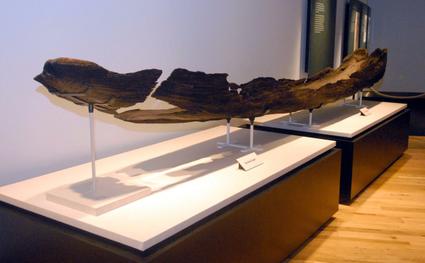Muhshoons, translated in the word “canoe or “kayak”, have been constructed by the Pequot people for thousands of years and is a tradition still in practice today. Since there were no horses in the area until the 1630s or 1640s, the main forms of transportation were either walking, running or using boats for many years. The rivers considered to be the highways of the time, and the muhshoons were the main way to travel.
Traditionally, muhshoons were used for fishing in deeper waters and traveling for trade up and down the coasts. Muhshoons were also used to travel inlands via river ways. The Pequot people had muhshoons up to 80 feet in length that were ocean voyaging vessels, almost like a cargo ship. I asked Nakai about the evolution of the muhshoon over time. “I think the best way to talk about the evolution of this type of transportation relates to the materials used.” Said Nakai, “In the past muhshoons were made of wood and today modern materials are used to construct them. However, talking from a cultural perspective, the muhshoons of today are constructed using traditional methods.”
As you can imagine, it takes a lot to turn a tree that looks something like this:

into a functional muhshoon that looks something like this.

I asked Nakai to describe a bit of what the process entails. The first step in the process is to find and harvest a large, fresh green tree. Traditionally, Pequot’s worked with white pine, chestnut, white oak, or tulip poplar. The outside of the muhshoon needs to be smooth so the next step is to peel off the bark. This is why the best time to start this process is in spring because the sap flowing through the trees makes the bark easier to peel. No materials were ever wasted so the peeled off bark pieces were then used to cover their traditional houses, or wetus. Now that the bark has been peeled, it is time to start transforming the tree into a muhshoon. This is when the burning process begins. The heat from the fire makes the sap in the tree boil, which seals and waterproofs the vessel. “I call it babysitting,” said Nakai, “because while it is burning you use clay or mud to keep certain areas from completely burning and as the embers burn down you would start carving out the sections into the shape of the muhshoon, hence the word dugout.” At the end of all this burning and “babysitting,” the Pequot’s would end up with a functional vessel that is ready to be deployed in the water.”
So here in New England, we know that it gets very cold in the winter and many of the waterways tend to freeze over with ice. This means that the Pequot people would not be using muhshoons as their main form of transportation during this time. To preserve the integrity of the muhshoons, they did something in the winter that may surprise you. Once the muhshoons were taken out of the water, two issues presented themselves. The first one is that due to their large size and weight, they were extremely difficult to transport over the land. The second issue is that once the muhshoons were removed from the water, they were prone to cracking and deterioration from completely drying out. Nakai went on to say, “In order to preserve them, Pequot’s and other tribes would often fill them with large stones and sunk below the freeze line to escape being crushed by ice and keep them from being damaged by repeated freezeing and thawing.” The muhshoons would swell with water and be protected from the dry winter air and ice.” Now that is some amazing science at work!

Seen in the photo above is a 17th century canoe that was discovered submerged at the bottom of the West Hill Pond in Winsted, CT in the late 1980s. “It was Native-made, but it actually shows evidence of metal tool marks, which indicates the canoe was made after European contact,” Nakai went on to explain. The Mashantucket Pequot Museum and Research Center was gifted the canoe and embarked on a project to conserve it for many years to come. The preservation process involved submerging the canoe into polyethylene glycol, which sealed it so it can now live permanently on display at the museum.
Nookumuhs is the name that was given to the muhshoon completed in the early spring and summer of 2015. The entire process was completed on the farmstead located at the Pequot Museum. “In August of 2015, the 36-foot long muhshoon was launched into the Mystic River with 12 individuals from various members of New England tribes onboard.” Nakai explained, “The muhshoon’s first voyage took them past the massacre grounds where hundreds of Pequot were killed in 1637, and three miles up the Mystic River to Noank, the first reservation established for the Pequot’s in 1666.
I was absolutely thrilled to sit down with Nakai and learn more about the history of the muhshoon for the Pequot people. The technology and science used in the building process and continuous preservation of the muhshoons made them a very successful mode of transportation for thousands of years.
If you want to learn even more about shipbuilding, check out our STEM Careers Connections: Density and Shipbuilding blog post.



